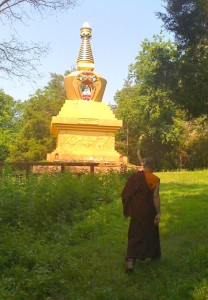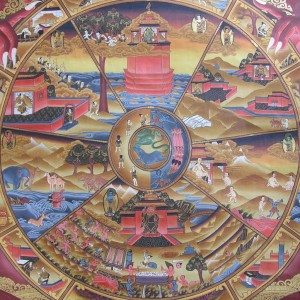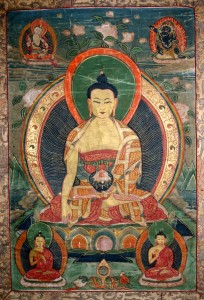To begin to develop Aspirational Bodhicitta is to understand the faults of cyclic existence, to understand the cessation of cyclic existence, to understand something of the nature of awakening or at least to understand that that is the cessation of suffering; and then to begin to develop from these foundational thoughts a caring and concern for all parent sentient beings. Aspirational Bodhicitta can take the form of just thinking as you ordinarily think. In the same way that you think of what will I have for dinner tonight, or in the same way that you think of what you would like to wear, or the ordinary things that we think of that concern ourselves. in that same ordinary way, without any kind of high-falutin’ dogma, you can begin now to develop a sense of the need and plight of sentient beings. And you can begin to speak what is in your heart, because it is in there somewhere in the natural state—the hope that all sentient beings will be free of suffering.
Each of you has a seed potential of that hope. You could not approach a truly spiritual path; you could not approach the Buddha’s teaching. You would have no karma to hear anything of the Buddha’s teaching if you did not have the hope that all sentient beings would be free of suffering. Because in order to be involved in these auspicious conditions, in order to hear the Buddha’s teaching, in order to have the opportunity to practice and the inclination to do so, in order to even begin the idea of moving onto a path that leads to supreme enlightenment, you must have accumulated an enormous amount of virtuous karma in the past and to accumulate an enormous amount of virtuous karma, there had to be kindness. So you should not be afraid thinking that you have no compassion.
Some people tell me they have no compassion. That is completely erroneous. That is impossible. But you must begin to dust off that jewel. You must begin to consider these foundational teachings, and to begin in whatever way you are comfortable with, to amplify and systematically develop Bodhichitta, the Aspirational Bodhicitta. You can begin to make wishing prayers for other sentient beings. One of the reasons why we built the Stupa that we built outside was to have a place here in this area that would have the fortunate quality of being able to enhance our prayers. Because of the cosmology of the Stupa—the way in which it is built, the empowerment that goes into actually consecrating it, and the wonderful relics that are present in it—because of the blessings of the prayer, the blessings of the mantra, because of all of these things, the Stupa actually has the ability, with faith, to amplify our prayers. We are taught to circumambulate in a clockwise direction making wishing prayers for all sentient beings. You can begin to do that. You can begin to make wishing prayers on your own, at any time. You can just think wishing prayers as you walk about. You can begin right now to developAspirational Bodhicitta in the same way that you develop muscle. You have the muscle fiber. You only need to strengthen it through use. That discipline is essential.
An excerpt from a teaching by Jetsunma Ahkon Lhamo called “Bodhicitta”
Copyright © Jetsunma Ahkon Lhamo. All rights reserved




